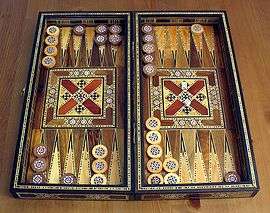Hounds and Jackals

Hounds and Jackals is the modern name given to an Ancient Egyptian game, that is known from several examples of gaming boards and gaming pieces found in excavations. The modern name was invented by Howard Carter, who found one complete gaming set in a Theban tomb that dates to the 13th Dynasty. The latter game set is one of the best preserved examples and is today in the Metropolitan Museum of Art in New York.[1] He called it Hounds contra Jackals. Another modern name for this game, but not so often used is fifty-eight holes.[2]
The gaming board has two sets of 29 holes. Gaming pieces are ten small sticks with either jackal or dog heads. Aim of the game was perhaps to start at one point on the board and to reach with all figures another point on the board. The game appeared in Egypt, around 2000 BC and was mainly popular in the Middle Kingdom.[2] In the 1956 movie The 10 Commandments, Pharaoh Seti and Nefretiri are depicted playing the game.
References
| Wikimedia Commons has media related to Hounds and Jackals. |
- ↑ William C. Hayes: The Scepter of Egypt, I. From the Earliest Times to the End of the Middle Kingdom, New York 1953 ISBN 0-87099-190-6, 250, fig. 160
- 1 2 Anne Elizabeth Dunn-Vaturi: Game of Hounds and Jackals, in: A. Oppenheim, d. Arnold, D. Arnold, Kei Yamamoto (editors): Ancient Egypt Transformed, The Middle Kingdom, New York 2015 ISBN 978-1-58839-564-1, 249, no. 188
